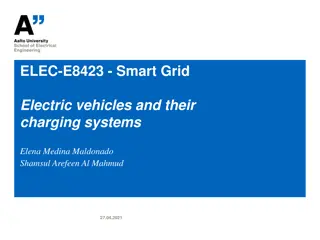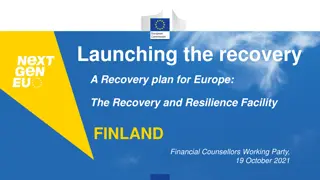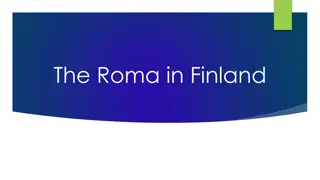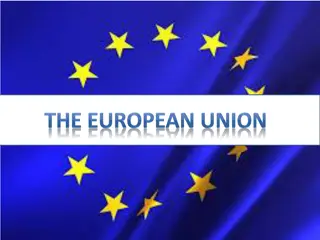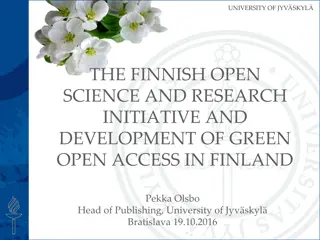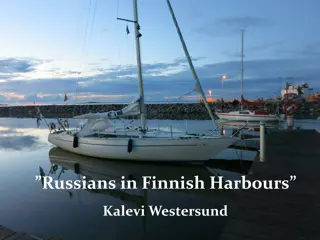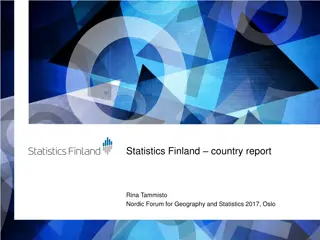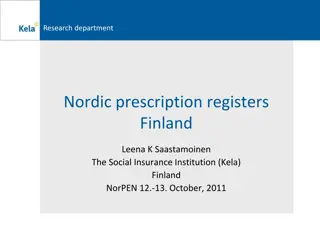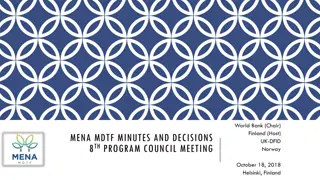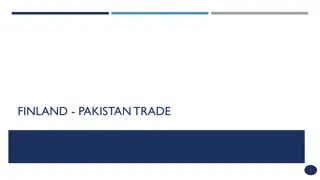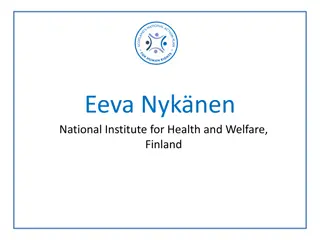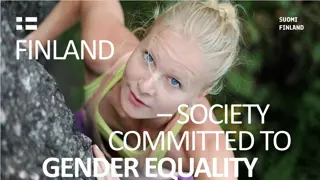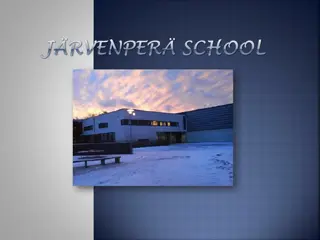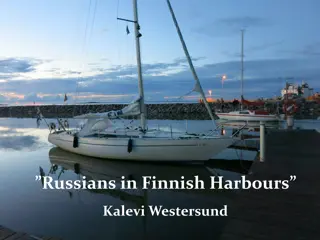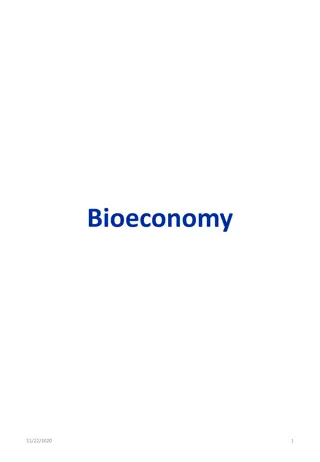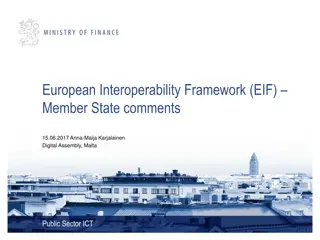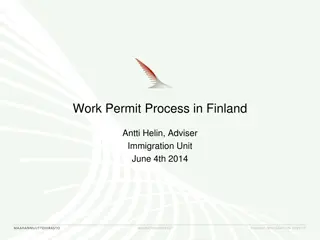Green Open Access in Finland: Why, What, and How?
This presentation discusses the importance of Green Open Access in Finland, exploring the reasons behind its adoption, different access models like Gold OA and self-archiving, and the role of university libraries in supporting and centralizing Green OA practices. It also touches upon the European Union's mandate for open access by 2020 and Finland's specific goals in this realm.
Download Presentation

Please find below an Image/Link to download the presentation.
The content on the website is provided AS IS for your information and personal use only. It may not be sold, licensed, or shared on other websites without obtaining consent from the author.If you encounter any issues during the download, it is possible that the publisher has removed the file from their server.
You are allowed to download the files provided on this website for personal or commercial use, subject to the condition that they are used lawfully. All files are the property of their respective owners.
The content on the website is provided AS IS for your information and personal use only. It may not be sold, licensed, or shared on other websites without obtaining consent from the author.
E N D
Presentation Transcript
A Service Model for Green Open Access in Finland Why, What and How? ILIDE 2017, Jasn , Slovakia 4.4.2017 Pekka Olsbo Head of Publishing Open Science Centre University of Jyv skyl
Three ways to open access Gold OA: Open access journals, which may or may not charge a publishing fee. Hybrid OA: Subscription based journals, where authors can buy their own articles open access. Self-archiving, also known as green open access, refers to the practice of depositing articles in an institutional repository or a subject repository. An embargo period is usually needed.
Why Green Open Access? The Finnish perspective In May 2016 the European Union announced that "all scientific articles in Europe must be freely accessible as of 2020" Also Finland has set its goals for open access: 60 % OA in 2017, 90 % in 2020. In Finland all researchers are encouraged (forced) to publish in journals listed in Finnish Publication forum How many open access journals do you think there are listed in Finnish Publication forum?
Why Green Open Access? Publication forum Level 3 (the highest level): 1,5 % OA-journals Level 2: 1,3 % OA-journals Level 1 (the lowest): 4,5 % OA-journals There is absolutely no way that Finland could in any way base it s development of open science in gold open access! Even though Finland has made hybrid OA deals with Taylor & Francis and Sage, and maybe one day with Elsevier too Not to mention what these deals would cost us.
Why Green Open Access? Of course we have to support OA- publishing and Gold OA, but alone these are not a solution to anything. Unless we make a total change of paradigm in scientific publishing, we ll need green open access (self-archiving) because: it s cheap, it s efficient, it s easy, it doesn t require (almost) anything from researchers, it gives tools for evaluating research output, and because it gives common good for everybody.
Whos business is green open access? Term self-archiving hints that it is the author, who should take care of green OA. BUT we believe it is not University libraries are the key players and librarians should take care of everything. Authors just take care of their files. Our experience suggest that in order to succeed, practices of green OA need to be centralized.
Situation in Finland Green OA in Finland 2013-2016 7970 3196 1333 980 2013 2014 2015 2016 Number of deposited articles in universities repositories
What has happened? A big step has been taken in creation of centralized services; population of CRIS (research information system) and process of self- archiving are now libraries business. Researchers don t have to worry about reporting of their publications or the green open access it is taken care of on their behalf. But this is reality only in few universities. So is everything ok and openness of Finnish research is on it s way up? No.
What is being deposited? 100.00 90.00 80.00 70.00 60.00 publisher pdf final draft pre print 50.00 40.00 30.00 20.00 10.00 0.00 Helda JYX AaltoDoc TamPub Deposited articles in 2015
If final drafts are not deposited Process of self-archiving is not working the way it should. We don t get anything from the authors. We just deposit what is already open somewhere else. We don t boost for open access. Openness in Finland does not increase. We are not doing what we should do! We are only wishing not acting!
Development of green OA 40.00% 35.00% 30.00% 25.00% Jyv skyl Helsinki Tampere Aalto 20.00% 15.00% 10.00% 5.00% 0.00% 2011 2012 2013 2014 2015 2016 Deposited articles in institutional repositories vs. total number of articles in 4 Universities in Finland
Development in University of Jyv skyl Openness peer rev. articles 60% 53% 51% 49% 50% 46% 40% 36% 32% 30% 20% 10% 0% Jan. 2015 April 2015 Feb. 2016 July 2016 Oct. 2016 Dec. 2016
Development in University of Jyv skyl Green OA peer rev. articles 49% 48% 50.00% 45% 45.00% 40.00% 36% 35.00% 27% 30.00% 25.00% 20.00% 16% 15.00% 10.00% 5.00% 0.00% Jan. 2015 April 2015 Feb. 2016 July 2016 Oct. 2016 Dec. 2016
How did we do it in the University of Jyv skyl ? Processes of CRIS and repository cataloguing and publishing work seamlessly together. Interoperability of IT-systems. A necessity. Question of expertise, learning process, growth of knowledge, working in a small group of specialists. Constant communication with researchers - show them benefits, make them think. Keeping it simple.
Service model for open science in University of Jyv skyl : Open Science Centre Centre started officially in January 2017 University library and University museums merged together All open science activities centralized Coordination of IT-services for research groups All publishing activities working together; publishing, cataloging, reporting, open access, system development The lifecycle of a publication in one hands
No demands for researchers but demand for services If we set goals for open science, we have to understand what these goals require: - infrastructure - services - open science goals have to be strategic goals Somebody needs to take the responsibility Need for centralized service models Open Science Centres
Thank You Questions?? Contact Pekka Olsbo Open Science Centre University of Jyv skyl pekka.olsbo at jyu.fi
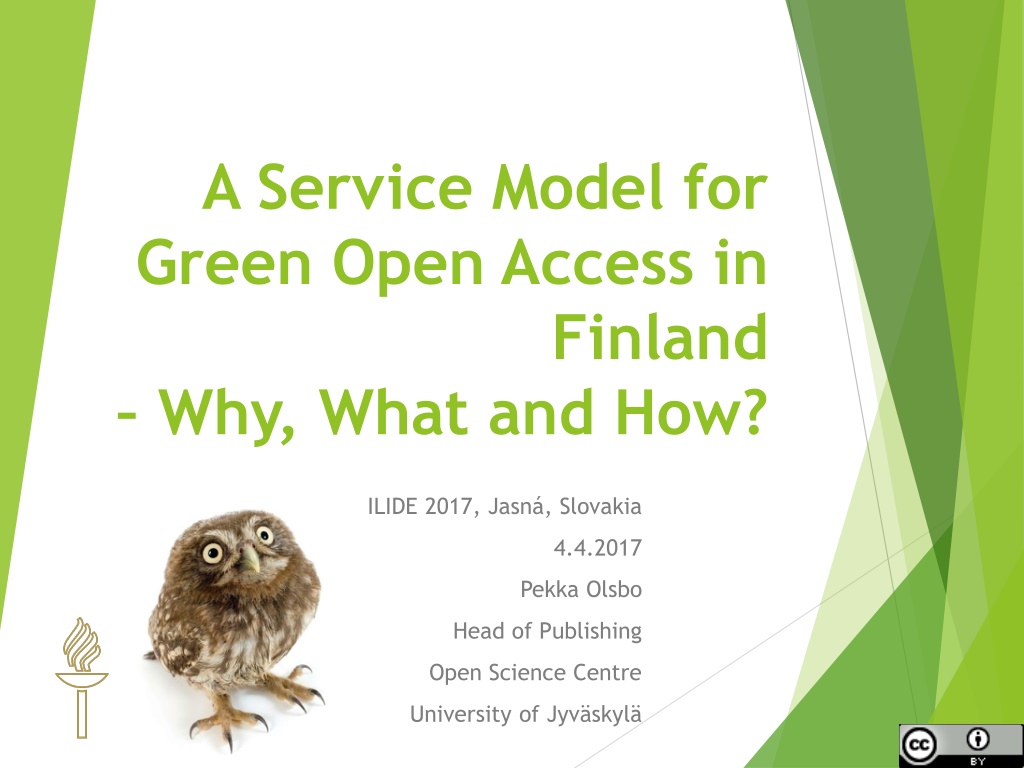
 undefined
undefined






